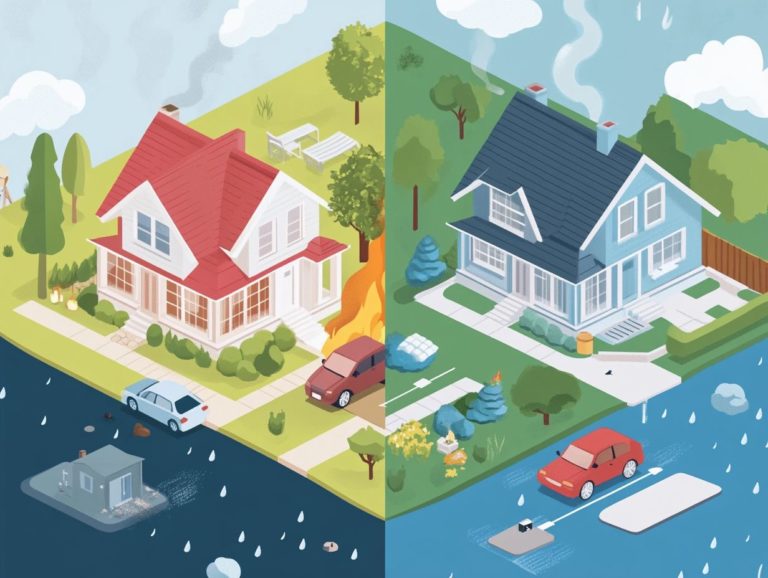Understanding Flood Insurance: A Necessity?
Flood insurance serves as a vital shield for homeowners and businesses, particularly in areas susceptible to water damage.
As climate change exacerbates unpredictable weather conditions, understanding the importance of flood insurance is more critical than ever.
This article explains flood insurance and its importance. It also guides you on how to assess your needs, secure the right coverage, and navigate the claims process effectively.
Protect your property with the right flood insurance!
Contents
Key Takeaways:

Flood insurance protects against financial losses from flooding, even in low-risk areas.
Standard homeowners insurance usually doesn t cover flood damage, leaving you vulnerable to costly repairs.
Consider location, property value, and risk when choosing coverage.
What is Flood Insurance?
Flood insurance is a specialized type of property insurance tailored to protect you whether you’re a homeowner or a commercial property owner from the financial repercussions of flood damage, which standard homeowners insurance often overlooks.
Managed through the National Flood Insurance Program (NFIP) which is run by the Federal Emergency Management Agency (FEMA) this important insurance provides essential coverage in flood zones, ensuring that you receive compensation for losses incurred during a flood event.
This insurance is vital because floods can strike anywhere, often without warning, leading to devastating financial consequences.
Unlike standard property coverage that typically addresses risks like fire or theft, flood insurance zeroes in on losses caused by rising waters.
The NFIP plays a significant role in making this protection both accessible and affordable, offering policies that can cover both the structure and its contents, depending on your chosen limits.
Typically, coverage amounts can range from $100,000 to $250,000 for buildings and up to $100,000 for personal belongings, helping you shield yourself from substantial financial risks associated with flood disasters.
Why is Flood Insurance Necessary?
Flood insurance is essential in today’s climate, given the rising frequency and intensity of flooding events. Homeowners should be aware of what to know about flood insurance for homeowners, especially in high-risk flood zones highlighted on flood maps.
This situation places many homeowners and property owners in a difficult financial situation.
Without sufficient flood coverage, you could be left grappling with staggering expenses for flood damage that standard homeowners insurance simply doesn t address.
Risk of Flooding and Coverage Gaps
Understanding the risks of flooding is essential for homeowners like you, especially since many might uncover unexpected vulnerabilities in their homeowners insurance that leave them exposed in high-risk areas.
The flood risks you face can vary significantly depending on whether you’re in a high-risk, moderate-risk, or low-risk zone, and recognizing these distinctions can highlight the necessity for a dedicated flood insurance policy.
In high-risk regions, such as New Orleans or certain parts of Florida, the chances of severe flooding are notably higher, often making it imperative to secure additional policies for adequate protection.
Conversely, if your home is situated in a moderate-risk area, you might still encounter unexpected water damage, yet many homeowners mistakenly assume they’re safe without supplementary coverage.
Standard homeowners policies generally exclude flood damage, exposing you to potential vulnerabilities that can lead to devastating financial repercussions.
It s crucial for you to carefully assess the specific risks associated with your property, taking into account local history and environmental factors to ensure you select coverage that aligns perfectly with your unique situation.
Types of Flood Insurance
You have two main options when it comes to flood insurance for your home or property: National Flood Insurance Program (NFIP) policies and privately issued flood insurance policies.
Each type presents distinct coverage options and premium structures, giving you the flexibility to select the perfect fit for your specific flood risk and financial situation.
National Flood Insurance Program (NFIP)

The National Flood Insurance Program (NFIP) is a federal initiative that provides affordable flood insurance for homeowners and business owners in participating communities. This program ensures flood victims receive timely financial assistance through a well-structured claims process.
If you live in flood-prone areas, NFIP policies are essential, as traditional property insurance may not cover flood damage. This program not only protects your property but also helps the community understand their risks and encourages participation in disaster preparedness strategies.
Local governments must adopt floodplain management regulations, enabling communities to reduce flood risk through effective planning and construction practices.
As a policyholder, you have tailored coverage limits for homes and businesses. Understanding the claims process is crucial for a swift recovery. Premiums vary based on factors like your property’s location and flood zone designation, making it vital to evaluate your insurance options thoroughly.
Private Flood Insurance
Private flood insurance has emerged as an exciting alternative to the National Flood Insurance Program, presenting you with flexible coverage options and potentially lower premiums if you re in a flood-prone area.
These policies can be tailored to fit your needs perfectly, filling the gaps left by NFIP policies while offering additional benefits.
As you explore these options, it s vital to weigh the advantages and limitations of private insurance. Some private insurers may provide more comprehensive coverage and faster claims processes, but these offerings can vary widely from one provider to another.
Think about how the age of your property and specific risk assessments might influence your premiums and available coverage types. Unlike NFIP, private options can be unpredictable, potentially leading to fluctuating rates and leaving you at risk of being underinsured during natural disasters.
Determining Your Flood Insurance Needs
Determining your flood insurance needs is essential for protecting your property. Start by considering your flood risk, the height of your property, and how much your building and contents are worth.
By evaluating these elements, you can secure sufficient financial coverage against potential flood damage, giving you peace of mind amid nature s uncertainties.
Factors to Consider
When contemplating flood insurance, evaluate factors like the age of your property, its location, historical flooding events, and the coverage amount you desire to protect against financial risks. Taking these elements into account will help you make informed decisions about your flood insurance policies.
If you live in an area prone to frequent flooding, opting for more comprehensive coverage might be wise. Conversely, if your home is in a historically drier region, you might assess your risk differently.
The age and condition of your property also significantly affect its vulnerability; older structures often lack modern flood-resistant features. Furthermore, elevation is crucial, as homes at lower elevations typically face higher risks.
By reflecting on these aspects, you can better assess your unique needs and prepare for potential financial repercussions from flooding.
How to Obtain Flood Insurance
Obtaining flood insurance requires a thoughtful approach, starting with an assessment of your flood risk. It s essential to choose an insurance agent who understands the complexities of flood insurance and can guide you through the selection process.
Familiarizing yourself with the specifics of your flood policy is crucial to ensure adequate coverage. Working with a knowledgeable agent can simplify this process and provide clarity on the claims process in the unfortunate event of a flood.
Don t wait until it’s too late get started on your flood insurance today!
Steps to Getting Coverage

The journey to securing flood insurance coverage starts with assessing your property’s flood risk. Then, consult with an insurance agent to explore policies tailored to your unique needs. This evaluation is crucial for determining the right coverage amounts and premium costs, ensuring you have strong protection.
Begin by reviewing local flood zone maps. This will help you understand your property’s classification and any flood history in the area. This initial step enables you to identify potential vulnerabilities and take informed action.
Next, contact a qualified insurance agent who specializes in flood insurance. They can provide valuable insights into various policy options, premiums, and available endorsements. Grasping the policy s terms, including coverage limits and exclusions, is essential for making informed choices.
By being proactive in this evaluation process and seeking expert guidance, you can secure coverage that genuinely meets your needs, offering peace of mind during uncertain times.
Filing a Flood Insurance Claim
Filing a flood insurance claim is essential. You must thoroughly understand the claims process outlined in your flood policy. Ensure that all necessary documentation is submitted to facilitate swift disaster assistance.
Engaging with your insurance agent will clarify and guide you through this crucial process, helping you navigate it with confidence.
Process and Tips for Success
To ensure a successful flood claim, familiarize yourself with the claims process in your flood policy. Collaborate closely with your insurance agent while documenting all flood damage. This proactive approach can significantly increase your chances of receiving timely compensation for your losses.
Staying organized is key. Maintain a comprehensive record of all conversations, including dates and detailed notes on what was discussed. When reaching out to your agent, don t hesitate to ask questions about any unclear policy terms, as understanding these nuances can help you avoid pitfalls later.
Photograph all damage and compile a detailed inventory of lost items. The more evidence you provide, the better your chances of a favorable outcome. Keeping open communication enhances trust and efficiency throughout your claims process, ultimately smoothing the path to compensation.
Frequently Asked Questions
What is flood insurance and why is it necessary?
Flood insurance is a type of policy that covers damages caused by flooding. It is necessary because most standard homeowners or renters insurance policies do not cover flood damage. Floods can occur anywhere at any time, leading to significant financial burdens.
Where can I purchase flood insurance?

You can purchase flood insurance through the National Flood Insurance Program (NFIP) or private insurance companies. NFIP is the only provider of flood insurance in certain high-risk areas.
Who should consider purchasing flood insurance?
Anyone living in a flood-risk area or who has experienced flooding in the past should consider purchasing flood insurance. This includes homeowners, renters, and business owners.
What does flood insurance cover?
Flood insurance typically covers structural damage to the building and its foundation, as well as damage to personal property like furniture and appliances. It may also cover temporary housing costs if the property is uninhabitable due to flood damage.
What does flood insurance not cover?
Flood insurance usually does not cover damages caused by mold, mildew, or moisture that could have been prevented by the property owner. Vehicles are also not covered, as they are typically included under separate auto insurance policies.
How much does flood insurance cost?
The cost of flood insurance varies based on the property’s location, flood risk, coverage amount, and policy type. On average, it can cost anywhere from hundreds to thousands of dollars per year.
If you haven’t secured flood insurance yet, now is the time to act! Reach out to a qualified insurance agent today to explore your options and protect your property.






